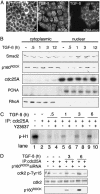TGF-beta-induced RhoA and p160ROCK activation is involved in the inhibition of Cdc25A with resultant cell-cycle arrest
- PMID: 14657354
- PMCID: PMC307605
- DOI: 10.1073/pnas.2536483100
TGF-beta-induced RhoA and p160ROCK activation is involved in the inhibition of Cdc25A with resultant cell-cycle arrest
Abstract
The ability of the transforming growth factor beta (TGF-beta) signaling pathways to inhibit proliferation of most cells while stimulating proliferation of others remains a conundrum. In this article, we report that the absence of RhoA and p160ROCK activity in fibroblastic NIH 3T3 cells and its presence in epithelial NMuMG cells can at least partially explain the difference in the TGF-beta growth response. Further, evidence is presented for TGF-beta-stimulated p160ROCK translocation to the nucleus and inhibitory phosphorylation of the cyclin-dependent kinase-activating phosphatase, Cdc25A. The resultant suppression of Cdk2 activity contributes to G1/S inhibition in NMuMG cells. These data provide evidence that signaling through RhoA and p160ROCK is important in TGF-beta inhibition of cell proliferation and links signaling components for epithelial transdifferentiation with regulation of cell-cycle progression.
Figures





Comment in
-
Another twist in the transforming growth factor beta-induced cell-cycle arrest chronicle.Proc Natl Acad Sci U S A. 2003 Dec 23;100(26):15290-1. doi: 10.1073/pnas.0307282100. Epub 2003 Dec 15. Proc Natl Acad Sci U S A. 2003. PMID: 14676328 Free PMC article. No abstract available.
Similar articles
-
Linking TGF-beta-mediated Cdc25A inhibition and cytoskeletal regulation through RhoA/p160(ROCK) signaling.Cell Cycle. 2004 Apr;3(4):408-10. Epub 2004 Apr 1. Cell Cycle. 2004. PMID: 14752278
-
Repression of the CDK activator Cdc25A and cell-cycle arrest by cytokine TGF-beta in cells lacking the CDK inhibitor p15.Nature. 1997 May 22;387(6631):417-22. doi: 10.1038/387417a0. Nature. 1997. PMID: 9163429
-
Reduction of Cdc25A contributes to cyclin E1-Cdk2 inhibition at senescence in human mammary epithelial cells.Oncogene. 2000 Nov 9;19(47):5314-23. doi: 10.1038/sj.onc.1203908. Oncogene. 2000. PMID: 11103932
-
Inhibition of RhoA/Rho-kinase pathway suppresses the expression of type I collagen induced by TGF-beta2 in human retinal pigment epithelial cells.Exp Eye Res. 2007 Mar;84(3):464-72. doi: 10.1016/j.exer.2006.10.017. Epub 2007 Jan 10. Exp Eye Res. 2007. PMID: 17217948
-
Rapid induction of p21WAF1 but delayed down-regulation of Cdc25A in the TGF-beta-induced cell cycle arrest of gastric carcinoma cells.Br J Cancer. 1999 Jun;80(8):1144-9. doi: 10.1038/sj.bjc.6690478. Br J Cancer. 1999. PMID: 10376964 Free PMC article.
Cited by
-
ROCK inhibition enhances microRNA function by promoting deadenylation of targeted mRNAs via increasing PAIP2 expression.Nucleic Acids Res. 2015 Sep 3;43(15):7577-89. doi: 10.1093/nar/gkv728. Epub 2015 Jul 17. Nucleic Acids Res. 2015. PMID: 26187994 Free PMC article.
-
A keratinocyte hypermotility/growth-arrest response involving laminin 5 and p16INK4A activated in wound healing and senescence.Am J Pathol. 2006 Jun;168(6):1821-37. doi: 10.2353/ajpath.2006.051027. Am J Pathol. 2006. PMID: 16723698 Free PMC article.
-
A bacterial cytotoxin identifies the RhoA exchange factor Net1 as a key effector in the response to DNA damage.PLoS One. 2008 May 28;3(5):e2254. doi: 10.1371/journal.pone.0002254. PLoS One. 2008. PMID: 18509476 Free PMC article.
-
TGF-beta1-induced plasminogen activator inhibitor-1 expression in vascular smooth muscle cells requires pp60(c-src)/EGFR(Y845) and Rho/ROCK signaling.J Mol Cell Cardiol. 2008 Mar;44(3):527-38. doi: 10.1016/j.yjmcc.2007.12.006. Epub 2008 Jan 3. J Mol Cell Cardiol. 2008. PMID: 18255094 Free PMC article.
-
Mechanisms of transforming growth factor β induced cell cycle arrest in palate development.J Cell Physiol. 2011 May;226(5):1415-24. doi: 10.1002/jcp.22477. J Cell Physiol. 2011. PMID: 20945347 Free PMC article.
References
Publication types
MeSH terms
Substances
Grants and funding
LinkOut - more resources
Full Text Sources

